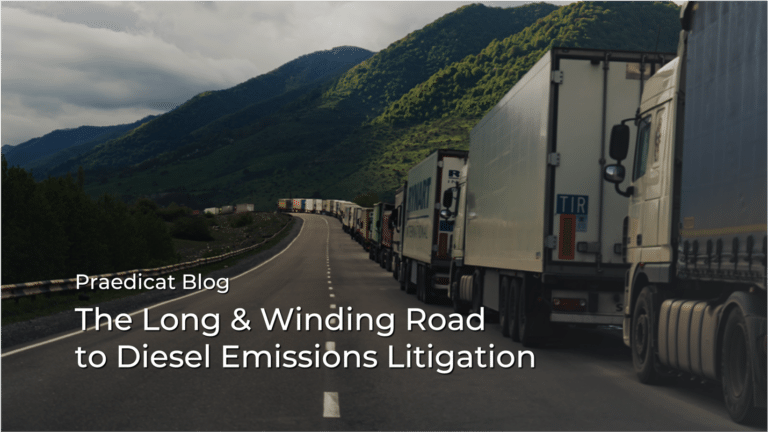The Long & Winding Road to Diesel Emissions Litigation
Anybody who watched a truck accelerate in the 1990s likely remembers the thick clouds of black diesel exhaust billowing out of the cab’s pipes. Scientists have long examined the potential consequences of people being exposed to those tailpipe emissions, and in 2011, then-California Attorney General Kamala Harris sued the ports of Los Angeles and Long Beach to force them to reduce their emissions. She won a settlement using California’s infamous Proposition 65’s requirement that residents would need to be warned of the health risks associated with their diesel exposure where the ports agreed to spend $1 million per terminal to upgrade their technology to reduce emissions.
Fast forward to 2022, and New York Attorney General Letitia James sued three New York City bus companies to force them to reduce diesel emissions. The allegations in that suit paralleled those of the California suit from 11 years prior: the bus operators disobeyed city and state anti-idling laws near schools in low-income communities, exposing youth to harmful diesel exhaust and jeopardizing their health. Like the action in California, a settlement ended the dispute and will reduce diesel emissions near communities at higher risk of developing health problems.
But why all this attention on diesel, a ubiquitous fuel that was even en vogue in passenger cars in the US until the Volkswagen emissions scandal emerged?
In a word: science.
Diesel emissions have been linked to a variety of long-term health harms both directly from the emitted chemicals and because the emissions contain a significant amount of fine particulate matter – PM2.5. The longest standing associations between diesel emission exposures and health outcomes are obvious: lung cancer and asthma. The most compelling link, however, is to cardiovascular disease, especially hypertension. Recently published science continues to validate these associations as well. For example, a study last year found that diesel emissions caused cardiac deterioration and increased likelihood of ischemic injuries in rats. Another study, this one on bus drivers, found an increased risk of cardiovascular disease in that population.
The strong consensus in the scientific literature about these effects of diesel emission exposure on people has created a situation where, if these cases were to be pursued in court, establishing general causation (GC) would likely be straightforward. Lung cancer has a GC risk score of 0.64, lung injury is at 0.79, and vascular disease has reached the top score possible of 1.0, showing that scientists are as certain that diesel emissions (mostly from the PM2.5 content) cause vascular disease as they are that asbestos causes mesothelioma.
You might then be wondering why, if the science is so strong, that mass litigation targeting these exposures hasn’t already begun. The answer lies in the other half of the legal equation: specific causation. In personal injury litigation the plaintiff needs to prove that they were harmed by the alleged exposure, not just that it could have in principle been the cause of the harm. Given the high incidence of cardiovascular disease and the understood multi-factorial causation, it’s difficult to pin its cause in one person on any one exposure (or even a small set of exposures). Similarly, we do not yet have methods to ascertain the causal factor(s) of lung cancer in non-smokers or in other lung injuries like asthma.
Despite these potential holes in a plaintiff’s argument, we can still estimate the likelihood that litigation will emerge and what it could look like. The Nekomodel projects the future evolution of scientific literature and the consequent possibility the some of the evidentiary issues I discussed above could be overcome. Because the scientific literature investigating the harmful effects of diesel emissions is quite active, we find a 16% chance that litigation will begin in the next 8 years. And because the population affected by these emissions is large and the harms are chronic, we find that the costs of this litigation are quite high – starting at approximately $52M on an economy-wide basis but growing to over $400M very quickly and a 5% chance the total economy-wide damages exceed $54B.
Those numbers assume that the “standard” mass tort paradigm applies where plaintiffs file individual suits claiming injury. But what about the 84% of the time where that type of litigation does not begin? The widespread harm of PM2.5 exposure from diesel exhaust may never lend itself to individual cases where plaintiffs can prove that diesel caused their injuries. Neither did the opioid litigation, though, and we see a route for state and local governments to try to solve a portion of the public health problems linked to diesel emissions via fourth-party litigation.
Since the Nekomodel does not predict “next opioids”-style litigation, we built a scenario to model the ramifications of such an event. We used various sources from the academic literature to estimate that approximately 10% of cardiovascular disease and 12% of autism spectrum disorders are caused by exposure to diesel emissions. Given the prevalence of these conditions, that accounts for 13.2 million cases of CVD and 417,000 cases of autism caused by diesel. The medical cost attributed to these CVD cases is almost $850B over the last 25 years and $92.8B for autism, including special education costs.
These stunningly large costs routinely make appearances in portfolio analyses, especially for portfolios containing companies in the oil and gas sector, trucking, engine manufacturing, engine repair, and other transportation companies for both people and goods. So the next time you look at your portfolio analysis results and wonder why diesel emissions play such a large role in total loss, it’s worth considering the accumulated scientific evidence telling us how important PM2.5 is for our health and the costs associated with the diseases linked to it.
Contact a member of our team to talk about our emerging interest risks


